Name of Rogers Park Art Deco Blg With Pool
Chicago is a urban center of firsts — and nowhere is this better seen than in its architecture. The site of the now demolished Home Insurance Building (1884 – 1885), credited as the world'southward outset skyscraper (at a diminutive ten stories by today's standards), you could write a book on the significance of the Chicago cityscape — which is why so many accept.
Here are 10 iconic, history-making examples of Chicago architecture, and the many reasons why you should pay them a visit.
1. Rookery Building
209 South. LaSalle St.
Architects: Daniel Burnham & John Root/Frank Lloyd Wright

On the National Register of Historic Places and designated a Chicago Landmark in 1972, The Rookery is located in Chicago'due south downtown Fiscal Commune. Information technology was constructed during a transitional period in architectural history, using both load-bearing masonry and a skeletal frame, which are distinguishing elements of the Chicago Schoolhouse of Architecture. Frank Lloyd Wright redesigned the striking two-story skylit antechamber in 1905-1907, recasting it in his signature Prairie style. Wright's work on The Rookery is his simply work on whatever building within the downtown cityscape.
2. Chicago Cultural Center
78 E. Washington St.
Architects: Shepley, Rutan and Coolidge

Across the street from Millennium Park and function of the Millennium Park Campus, the "People'due south Palace" opened in 1897 to serve two purposes: Equally the commencement permanent domicile for the Chicago Public Library (the building'southward Washington Street side), and as the headquarters for the Chiliad Ground forces of the Republic, the Civil War Union Army veterans' organization (the building's Randolph Street side). In 1991, it was rededicated every bit the Chicago Cultural Center, and became the nation'due south offset free municipal cultural middle, hosting complimentary concerts, art exhibitions and other programming throughout the year.
Listed as a Chicago Landmark and on the National Register of Celebrated Places, the edifice was designed in the Classical Revival style, taking inspiration from the monumental structures of aboriginal Hellenic republic and Rome, and the finely detailed buildings of the Italian Renaissance.

Architectural elements of annotation include the Washington Street Lobby, withmosaics of glass, gilded leaf, female parent of pearl and precious stones; and Preston Bradley Hall, combining glass mosaics with a luminous 38-foot-bore dome by the Tiffany Drinking glass and Decorating Visitor of New York. Information technology is, in fact, the largest Tiffany dome in the globe, containing approximately 30,000 individual drinking glass pieces.
FREE 45-infinitesimalbuilding tours are conducted at one:15pm from Wed through Saturday.
3. Wrigley Edifice
400 Due north. Michigan Ave.
Graham, Anderson, Probst & White

Seville Cathedral's Giralda tower combined with French Renaissance details are the inspiration behind the Wrigley Building. Comprised of two towers of differing heights connected by walkways, the building is clad in glazed terra-cotta, which makes its white façade gleam in the sunlight and evening floodlights. The south clock tower features clock faces of more than 19-feet in diameter, pointing in all four directions. Some other striking feature of the edifice is the fact that, equally you lot walk through the center doors, you find yourself in a secluded park area that overlooks the Chicago River. Which brings me to another reason to visit the Wrigley Building. Information technology sits on the banks of the laurels-winning Chicago Riverwalk, ane of the city's leading attractions. This 1.25 mile pedestrian-friendly stretch extends from Lake Shore Drive to Lake Street, and features intimate coves, informal cafes, wineries and bars, public art, monuments, museums, and a boatload of excursions on the h2o.
4. Tribune Tower
435 N. Michigan Ave.
Architects: Howells & Hood
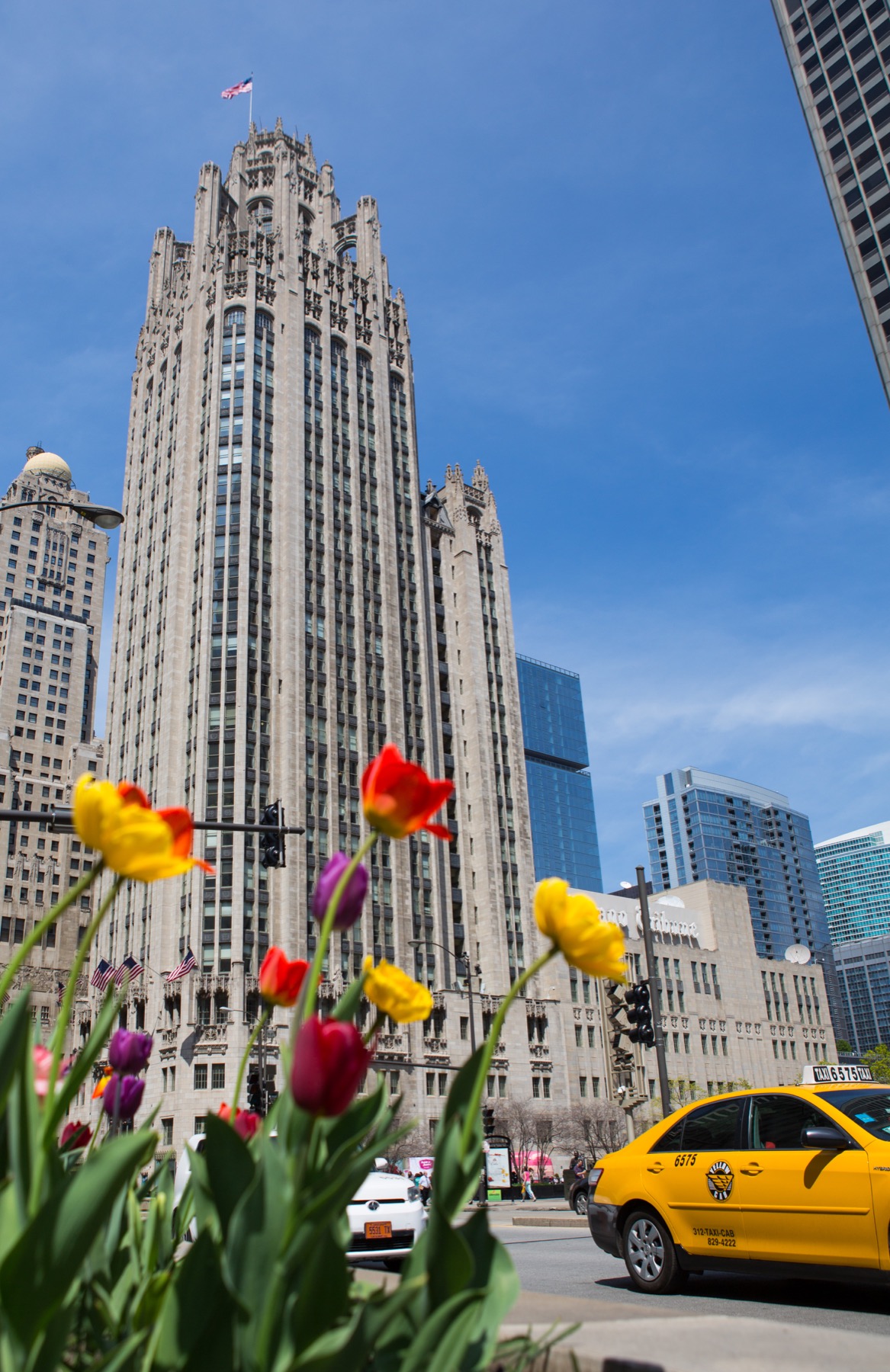
Standing beyond from the Wrigley Building, a Chicago Tribune competition in 1922, marker the newspaper's 75th ceremony, inspired a flood of international entries seeking to create "the most beautiful and distinctive office building in the world." New York firm Howells & Hood trounce out over 250 concepts with its Gothic Revival limestone blueprint, featuring elegant buttresses, intricately carved stonework and an octagonal campanile.

As the Chicago Architecture Center explains, the blueprint "used architectural ideas borrowed from the by. The lower function cake is sheathed in Indiana limestone with vertical piers and horizontal spandrels characteristic of Fine art Deco. The building's crown recalls a Medieval European tower, imitating the Butter Tower of the 13th-century Rouen Cathedral in France. Within, visitors encounter a Hall of Inscriptions. Carved into the lobby walls are famous quotations from Benjamin Franklin, Voltaire, Thomas Jefferson and James Madison, praising and exalting freedom of the press."
In keeping with the concept of borrowing from the past, the Tribune Tower's facade incorporates some 150 fragments from celebrated buildings and sites, including the Winter Palace in Beijing, Westminster Abbey, London, the Great Pyramid in Giza, The Neat Wall of China, and the Parthenon in Athens.
five. TheMART (formerly the Trade Mart)
222 N. Merchandise Mart Plaza
Architects: Graham, Anderson, Probst and White
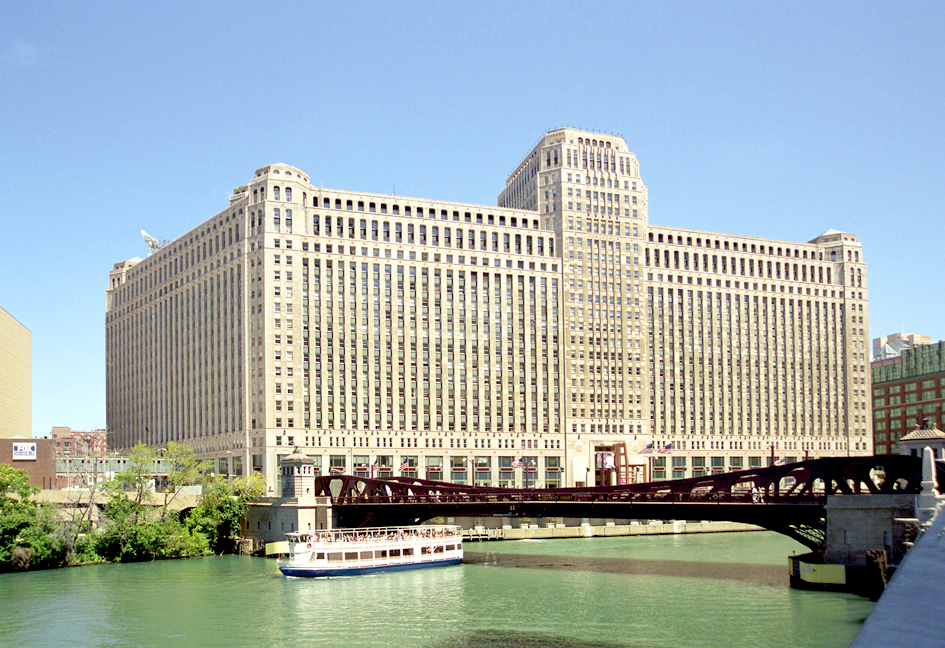
Covering two city blocks and ascension 25 stories at the junction of the North, Due south and Main branches of the Chicago River, theMART was originally developed by Marshall Field & Co. to create a central marketplace where retailers could come up to buy their wares all under i roof.
Original designer Alfred Shaw communicated the unique, mod concept of theMART with Art Deco aesthetics and the integration of elements from three building types: the warehouse, the department store and the skyscraper office building.
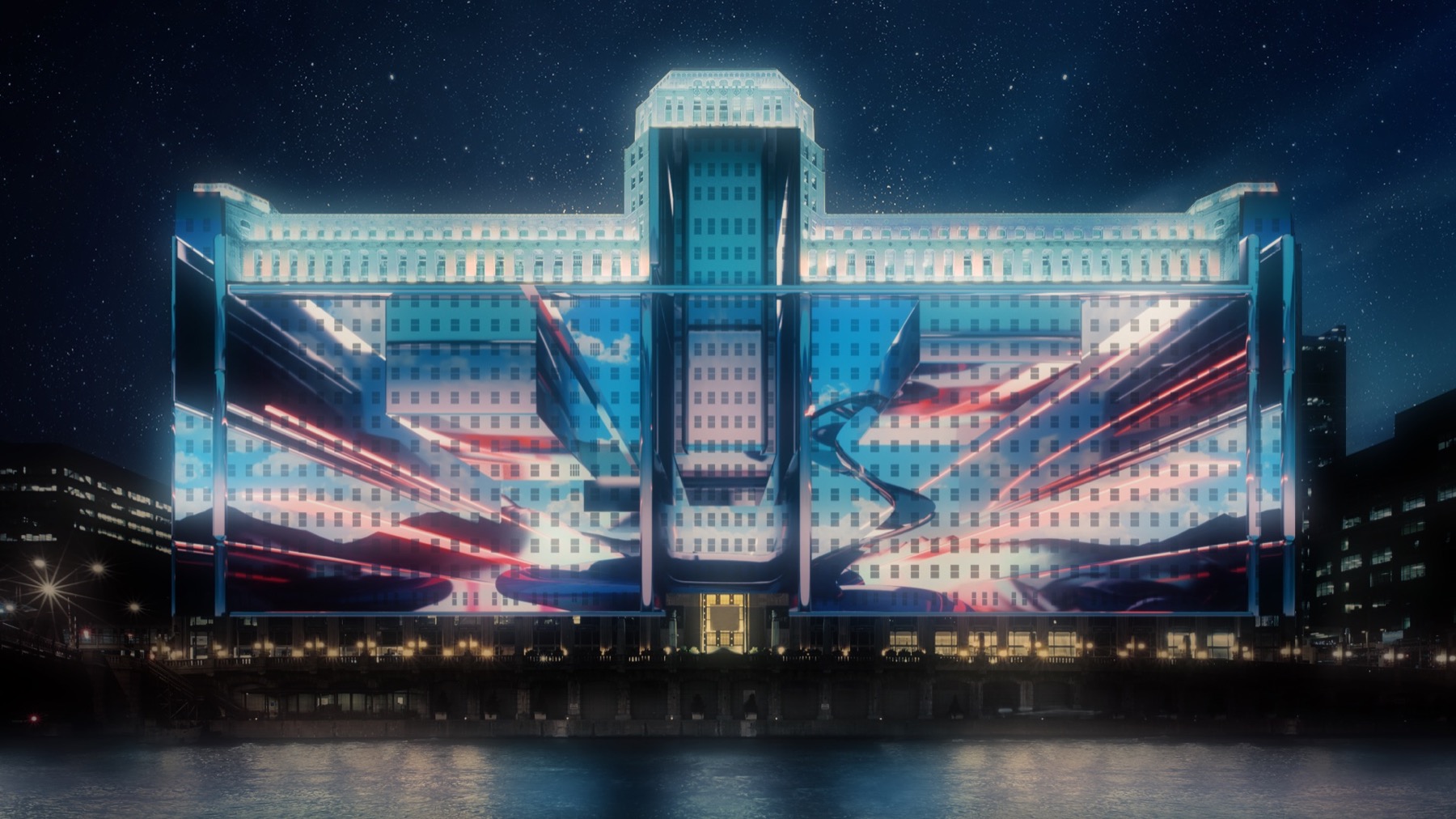
On September 29, 2018, theMART will make history with the launch ofArt on theMART, the longest-running and largest digital fine art projection in the world. The starting time-of-its-kind for Chicago, this curated series of digital artworks volition exist projected beyond 2.5 acres (the equivalent of two football fields) of theMART's river-facing façade.
half-dozen. Marina City
300 N. Land St.
Architect: Bertrand Goldberg
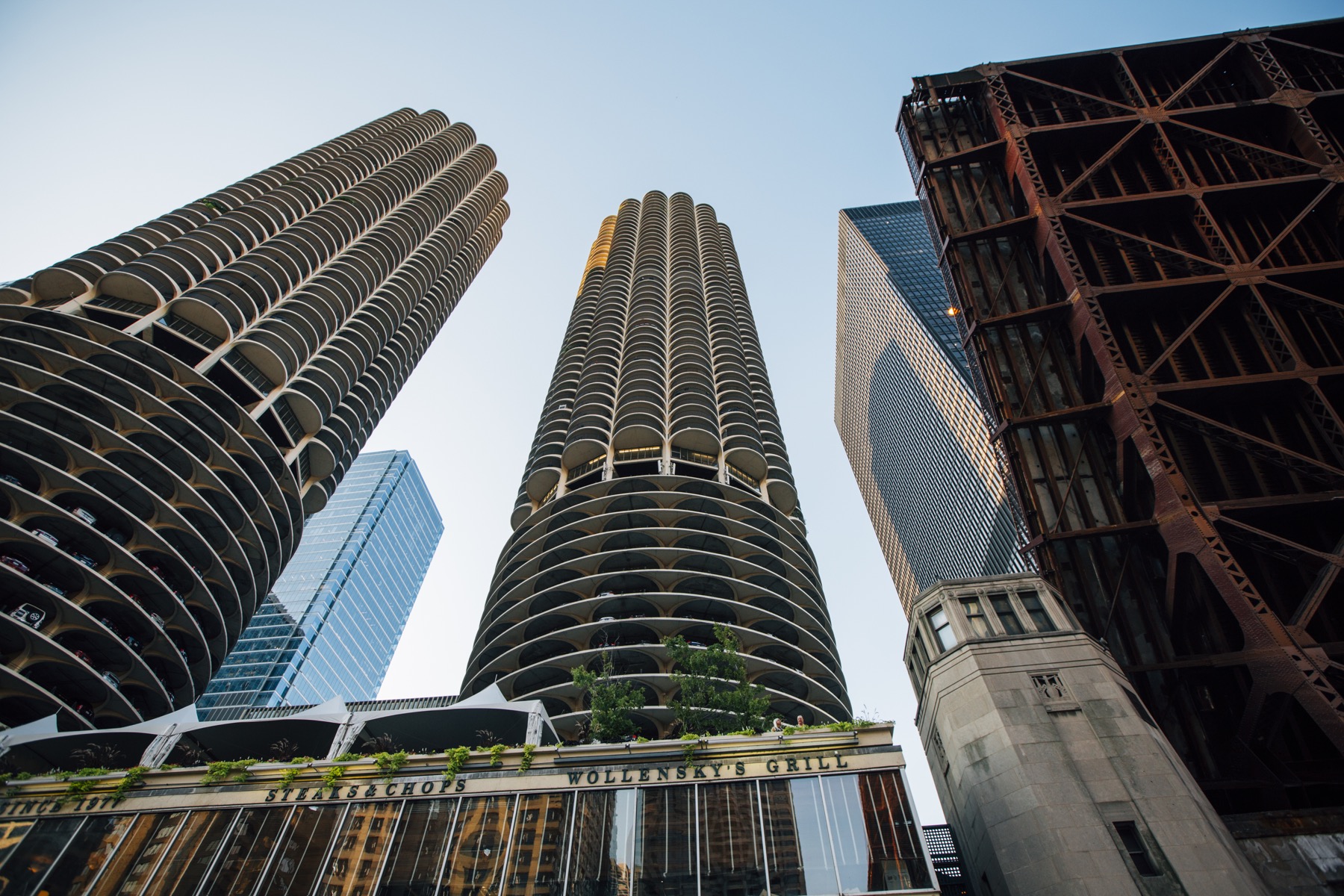
If Marina City looks particularly familiar, information technology may be because you're a Bob Newhart fan. The building featured prominently in the opening credits of the Bob Newhart Show. Located forth the primary branch of the Chicago River in downtown Chicago, Marina City's distinctive pattern features 2 cylindrical 588-foot towers that bear a hitting resemblance to corn cobs. At the time of its opening, this designated Chicago Landmark was the tallest residential building and tallest concrete structure in the world. Two notable features of the complex are the House of Blues and the luxuryHotel Chicago, a 354-room Marriott. On the marina level, you can rent a pocket-size electric boat and explore the Chicago River.
7. 875 Due north Michigan Ave (formerly the John Hancock Heart)
875 North. Michigan Ave.
Architects: Skidmore, Owings & Merrill

One of the world's most recognized skyscrapers and an iconic example of late-20th century Chicago architecture, 875 Northward. Michigan Ave. exudes masculine simplicity, with "its expressive structural organization and gently sloping façades," The Skyscraper Middle explains. The Heart adds that, "The architectural form of 875 North Michigan Avenue represents a radical departure from established aesthetics of the fourth dimension. Initially, critics labeled the edifice equally too industrial, simply over time it has come to symbolize the gutsy tradition of structural expression in Chicago." Among the skyscraper's draws for both locals and visitors is The Signature Room on the 95th floor, featuring fine dining with panoramic views of the Chicago skyline and Lake Michigan. What'due south more,360 CHICAGO observation deck is unlike whatsoever other. Located k feet above the famed Magnificent Mile, the deck offers breathtaking 360 degree views of the metropolis, and is home to TILT, an enclosed moving platform that literally tilts yous over Michigan Avenue from the 94th Floor.
Check out ways to save on 360 Chicago and other top Chicago attractions.
8. Ane Illinois Centre
111 E. Wacker Bulldoze
Architect: Mies van der Rohe
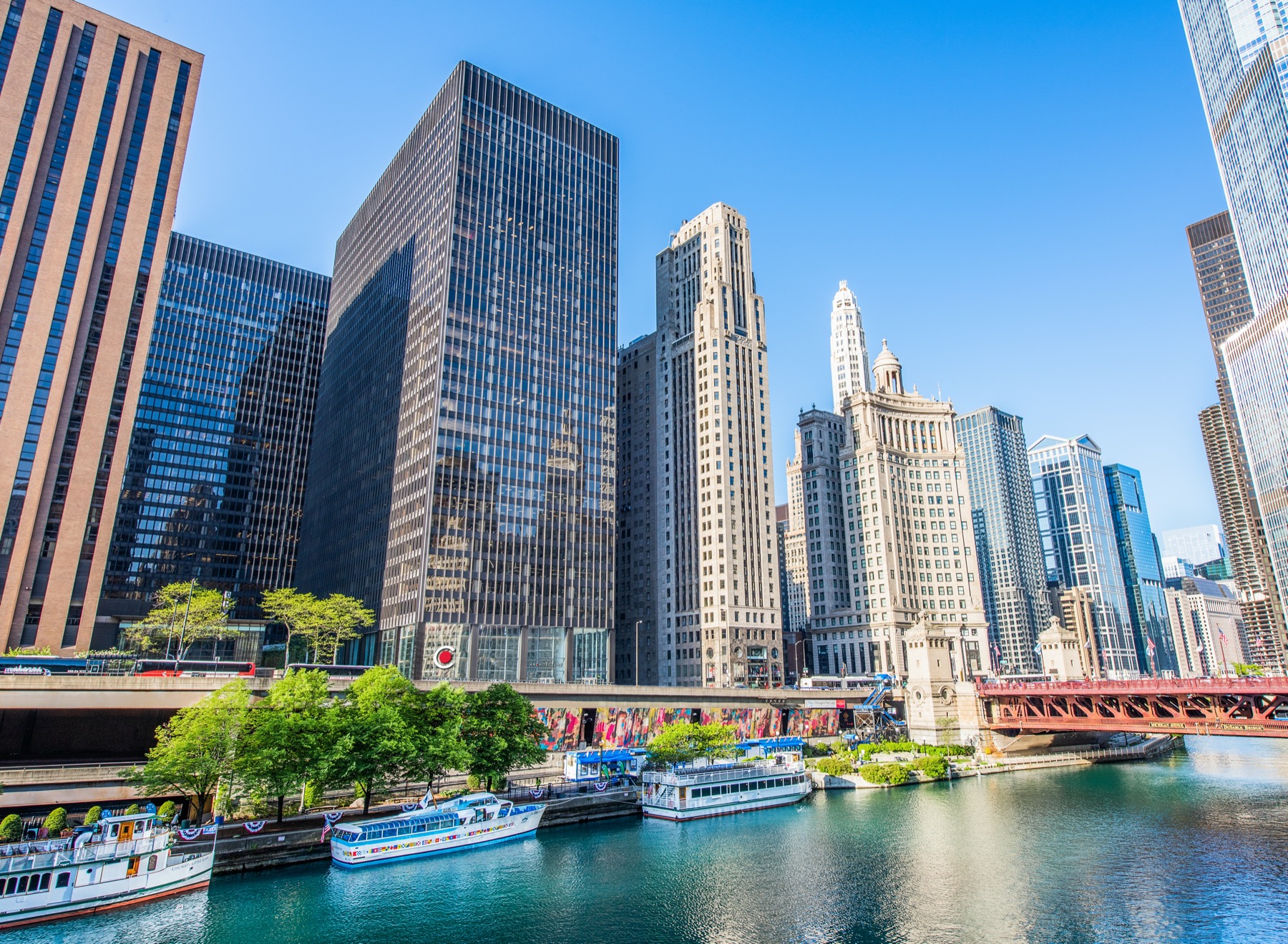
Fittingly, the new Chicago Architecture Center has fabricated One Illinois Center its home. This is one of Mies van der Rohe'southward final designs, rise in a higher place a former rail yard and the site of Fort Dearborn (1803), the US Ground forces'due south westernmost postal service. When ground broke on One Illinois Heart in 1967, it was the starting time building synthetic on the site. Information technology is notable for its International Style, incorporating elements of Mies' earlier work and the ideas he brought with him from pre-WWII Germany. The International Style is marked past an accent on volume, with the use of planes of glass to encase spaces versus masses of brick or stone, and a dependence on the elegance of materials and technical perfection over practical ornamentation. Mies died in 1969, just a year before the building opened.

Aside from the significance of the architect and his architecture, One Illinois Middle is today known for the newly opened Chicago Architecture Center, a cutting-edge museum that incorporatesstriking and immersive exhibits, includingBuilding Tall, a room filled with super-sized calibration models of famous skyscrapers from around the globe, with towering panes of glass that await out upon the Chicago Riverwalk, Wrigley Building and Tribune Tower. For a truly singular feel, hop onto the Chicago Compages Center's Compages River Prowl aboard Chicago's Starting time Lady Cruises,Chicago's #1 tour according to TripAdvisor users.
9. Willis Belfry
233 S. Wacker Bulldoze
Architects: Skidmore, Owings & Merrill
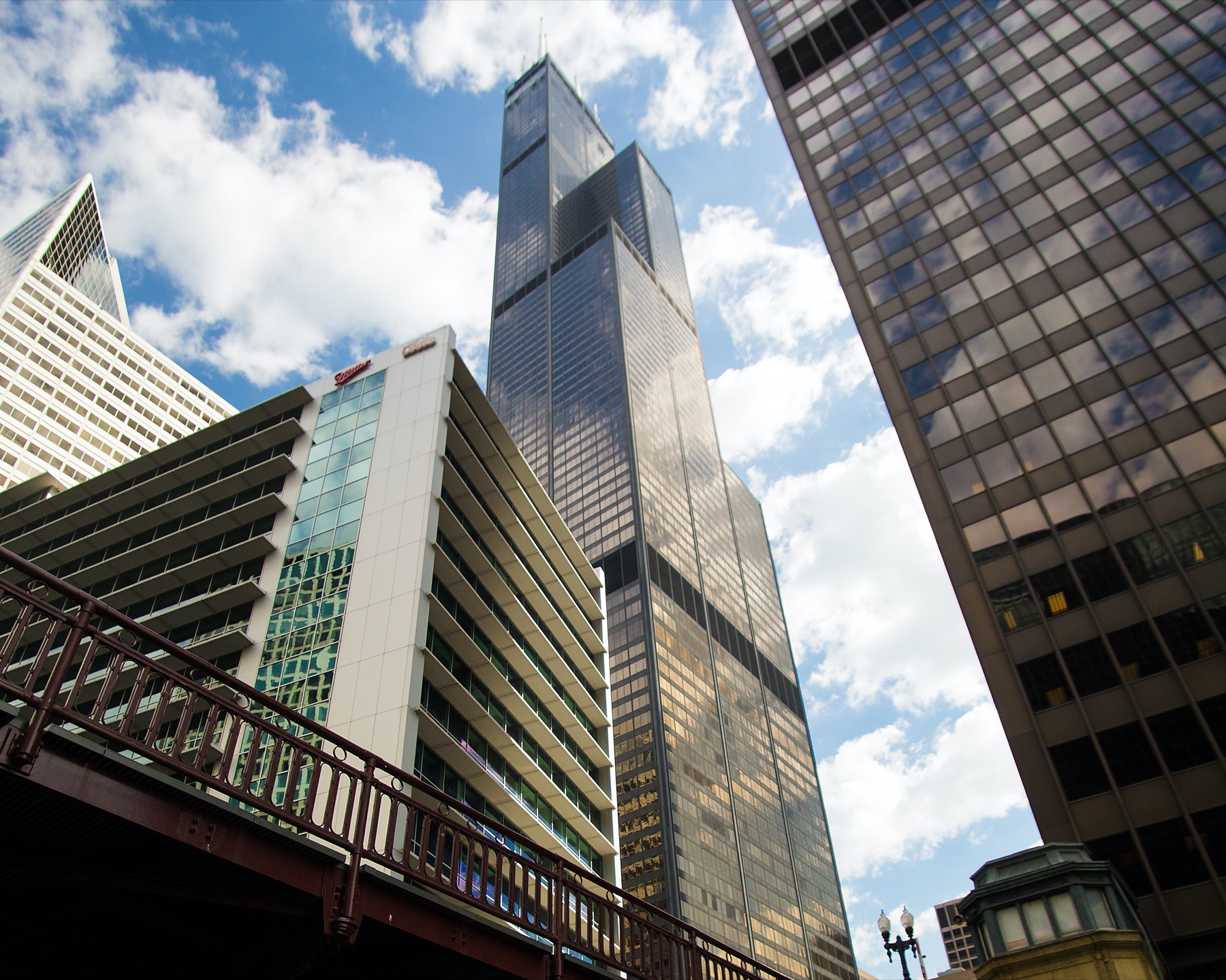
Formerly known as the Sears Tower and located in the heart of downtown Chicago, Willis Tower is a 110-story, 1,450 human foot ((442.ane chiliad) edifice, making it the second tallest building in the Western Hemisphere (first place was claimed by 1 World Merchandise Center in New York in 2014). In 2009, a multi-million -dollar renovation of the Willis Tower's observation deck, Skydeck Chicago, was conducted, including the evolution of The Ledge, a serial of glass bays on the 103rd floor that extend from the building to provide visitors with unobstructed views of Chicago through the windows and glass floors – 1,353 feet straight down. In addition to The Ledge, the new Skydeck visitor heart features museum-quality interactive exhibits.
Check out means to save on Skydeck and other top Chicago attractions.
ten. Aqua Tower
225 Due north. Columbus Bulldoze
Architects: Jeanne Gang of Studio Gang Architects

Bridging the gap between skyscraper and sculpture, the Aqua Belfry is located near the shores of Lake Michigan, and, as its name implies, is inspired by the motility and qualities of h2o. This shimmering multi-use edifice includes the luxury Radisson Blu Aqua Hotel. The design of the 80-story edifice connects strongly with the outdoors, with terraces that give it its distinctive undulating advent. Also, a 82,550 sq ft (vii,669 yard2) terrace features gardens, gazebos, pools, hot tubs, a walking/running track and a burn pit. The Aqua is the recipient of multiple awards and accolades, including the Emporis Skyscraper Award every bit 2009 skyscraper of the twelvemonth.
Insider tip
Open Business firm Chicago
Have you ever walked by an interesting Chicago building and wished you could take a peek inside? Y'all'll get your chance during Chicago'due south annualOpen up House Chicago, a free public festival hosted past the Chicago Architecture Center. More than 200 pregnant buildings throw open up their doors for self-guided tours. Structures located in 20 different neighborhoods range from soaring skyscrapers to opulent mansions and sectional private clubs, many of which are rarely open to the public. No tickets or registration are required, and you can build your own itinerary based on your must-sees.
joneshamakfame1944.blogspot.com
Source: https://www.choosechicago.com/blog/architecture-history/10-iconic-buildings-in-downtown-chicago/
Post a Comment for "Name of Rogers Park Art Deco Blg With Pool"